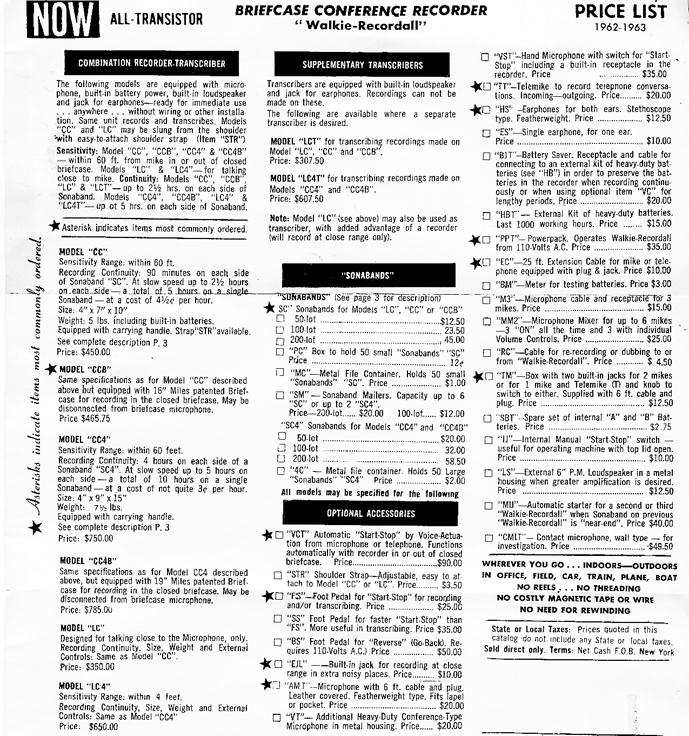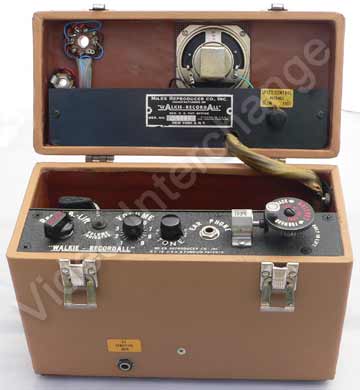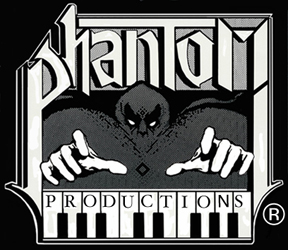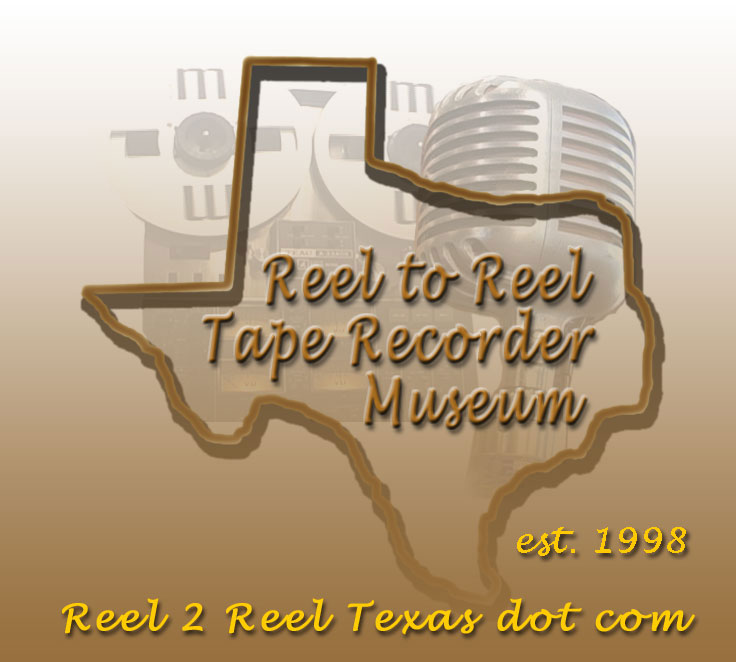|
Reel2ReelTexas Analog Reel To Reel Tape Recorder OnLine Museum Phantom Productions, Inc. • "creative entertainment and production since 1964"
Unfortunately the DVD set is no longer available • Click Here for more info check out our FOR SALE page Share
|
|
This is a compilation of information about the Walkie Recordall found on the web

This late-model Walkie-Recordall contains a 4.8 microcurie radium source. An expensive dictation recorder in its day (ca. 1950s and ’60s), the battery-operated apparatus came in a discreet suitcase with hidden microphone—perfect for industrial espionage. Radium was used to discharge static on the “sonoband” embossing medium. This specimen was found by scintillation detector in a flea market in Ohio. The included sonoband, containing a medical lecture, was heavily damaged by radiation in the place where it sat in front of the radium source for years. The band still plays (video coming shortly). I pay $50 per Walkie radium source; taking out this radioactive strip does not impact operability of the recorder.

http://www.pimall.com/NAIS/pivintage/walkierecordall.html

Walkie-Recordall, -Circa 1930's, 1940's
The Walkie-Recordall was a portable audio recorder that recorded to a plastic type belt (see photos below).The belt was called a Sonoband. The recorder measures10.5 x 5 x 9 with the thing closed up. A needle etched the sound onto the Sonoband. The belt measures 16.5 x 1.75. The Walkie-Recorderall was developed as a dictation machine. The idea was that salesman and business people could carry the thing around and dictate memos which could later be typed up into business reports on typewriters. However, the Walkie Recordall never went over very well for that. However, because of it's portability and recording power, it was quickly adapted as a covert audio recorder by law enforcement and private investigators. It was highly popular in the 1930's and 1940's. it retailed for about $450.00. That was a lot of money then considering the fact that the average sold middle income paycheck about between $45.00 and $55.00 a week. That is over two months pay for a recorder. The Sonoband belt would record for about an hour. That was a really a long play recorder back then. Later models had Sonobands that would record several hours.
You can learn more about the Walkie Recordall from these web site links
The History Of Sound Recording
Links on the Walkie Recordall From The Reel2Reel Museum
http://www.videointerchange.com/audio_history.htm

Sonaband - Walkie RecordAll (1957)
The Sonaband machines used the same technology as that of the Dictabelt. Namely that it embossed the audio information onto a soft vinyl belt with a stylus, instead of cutting grooves into harder materials such as acetate.
There were 4 different models.
LC Basically the same as the CC, but only had a standard microphone where one had to be close to the mic.
LC4 Similar to the CC, but had a better microphone with a useful range to 4 feet and accepted the larger belts
CC This unit could record up to 1 hour on each side of the belt. Microphone range was 60 ft.
CCB Same as the CC, but came with the "covert" briefcase.
CC4 Identical in function to the CC, but was larger and took larger belts, allowing up to 270 minutes of recording time.
CC4B Same as the CC4, but included the "covert" briefcase
1962 Prices:
LC $350.00
LC4 650.00
CC 450.00
CCB 465.75
CC4 750.00
CC4B 765.00
To equate those prices into today's (near worthless) 2008 "fiat" dollars, multiply the price by 7.04. Thus a CCB (the model we have and shown here) if it were being sold in 2008 would cost $3280.
Museum Rescues 'Endangered' Recordings
Walkie-Recordall Ad
http://electro-music.com/forum/post-96266.html
My grandfather game me two of these:
The Walkie-Recordall
Advertisements for another phonograph-type recorder, the Walkie-Recordall, are known from 1953-54, but the machine was probably available before and after that.. It was marketed by the Miles Reproducer Corp., which was at one time a fairly prominent firm in the audio-visual field. This oddly named device recorded sound in a groove on a wide plastic belt called a "Sonoband." These bands held several hours of audio and sold for just 25 cents. The recorders in 1954 came in two basic models, the CC "Conference Recorder," at $450, was a four-pound portable that operated on batteries. A variation was the model CCB, which was the same type of machine housed in a briefcase and marketed as a device for making secret recordings. It retailed for $465.75. The CC-type machines recorded for up to 90 minutes on each side of the Sonoband. The CC4 was used for making long-duration recordings of up to eight hours (four hours per side).
(from www.recording-history.org )
Walkie RecordAll (open and closed case)
A sonoband slips on to the spools and a needle etches the recordings on the band. The compact, portable device was activated by turning the black button on the top.
Sonobands
A sonoband is a flexible plastic band and permanent medium. Each band is made of a flexible, durable, Mylar-like material 2 inches wide, with a diameter of 5-1/2 inches. (from http://www.eurekalert.org/pub_releases/2005-05/fm-mr050305.php)
My grandfather was a court stenographer in Pennsylvania in the 1960s, and he was asked to purchase two Walkie RecordAlls (manufactured by the Miles Reproducer Co., purchased in Manhattan) to record conversations during court sessions behind closed doors. He bought the "model CCB, which was the same type of machine housed in a briefcase and marketed as a device for making secret recordings [which] retailed for $465.75" (www.recording-history.org).
I'd love to find blank Sonobands, as my grandfather was unable to show me how they worked (and they still do) because all of the Sonobands he used were property of the court. The store he purchased them from in Manhattan, Kulik's, is long gone, as well as the Miles Reproducer Company.
Also, being that they retailed for $465.75 back in that time, it would be great to see how much they are worth - but I guess that's an Antiques Roadshow kind of thing.
I guess this is more of a tribute page, so I'll take some pictures of the recorders tonight and add them to this thread.
Who knows, maybe someone here has used one, or more importantly, knows how to obtain or MAKE blank Sonobands, a "Mylar-like material 2 inches wide, with a diameter of 5-1/2 inches."
Thanks! http://www.oneplayergame.com
"Walkie Recordall"
To: "RADSAFE" <radsafe@romulus.ehs.uiuc.edu>
Subject: "Walkie Recordall"
From: "Radiological Health Unit" <raldrich@emi.com>
Date: Fri, 2 Apr 1999 14:27:50 -0500
We recently found a device in a load waste traced to someone cleaning out a
basement. Its a wooden case with dimensions approximately 1ft x 1ft x 6 in.
On the front is the label "Walkie Recordall". The top of the case is hinged
and inside is what appears to be a primitive tape recording system. The
base of the case is a detachable battery pack. The general impression of
the device is a WWII vintage portable tape recorder.
Radiation readings on the surface of the case are 2-3 mR/h and down inside
the device (as far as the probe could reach) the readings are around 20
mR/h. We suspect radium, but this is not confirmed. The person who owned
the device is believed to have been a flight surgeon in the pacific during
the War.
Anybody seen one of these things before?
************************************************************************
Clayton Bradt, CHP <raldrich@emi.com> phone: 518/457-1202
Assoc. Radiophysicist fax:
518/485-7406
NYS Dept. of Labor
Radiological Health Unit
Blg.12, Rm 169
State Office Campus
Albany, NY 12240
Contact: Greg Borzo
gborzo@fieldmuseum.org
312-665-7106
Field Museum
Museum rescues 'endangered' recordings
Field Museum preserves audio descriptions of prized Pacific collection recorded on sonobands, an 'endangered species' of information technology
Unloading 72 crates, in all, at The Field Museum in 1958. Each weighed 16 tons.
Full size image available here
CHICAGO--In 1958, Field Museum curator of the Pacific, Roland Force, sat down with Captain A.W.F. Fuller to record more than 100 hours of comprehensive information about the 6,622 artifacts in Fuller's Pacific collection that had been acquired over the previous half century. They used a Walkie RecordAll, then a state-of-the-art recording device, and write-able media tapes called sonobands. Today, the Museum is having these recordings converted to a digital format, which is proving to be quite a challenge.
Much as reel-to-reel tape recorders and eight-track cassettes have been relegated to the technological dustbin, the Walkie RecordAll and the sonoband medium on which the device etched sounds fell out of use in the 1970s. Today this technology is as imperiled as an endangered species, such as the panda or snow leopard. In fact, the full-service archival lab that the Museum contracted to preserve the recordings did not possess a machine of this type.
In the 1950s and 60s, the boxy, battery-powered machines were commonly used in the legal profession and by the Chicago Police Department to make legal recordings in criminal cases. They were also advertised as a way to secretly record conversations.
A large, rare, carved wood idol thought to be the mate to the famous "Bloxam" idol.
Full size image available here
Fortunately, The Field Museum had kept the two Walkie RecordAll machines used for the Fuller-Force recording sessions. It has loaned these functioning devices to the contractor, the Cutting Corporation in Bethesda, Md., for this project. Otherwise, the voices describing the masks and skulls, weapons and tools, idols and boomerangs, might have been lost.
Fortunately, The Field Museum had kept the two Walkie RecordAll machines used for the Fuller-Force recording sessions. It has loaned these semi-functioning devices to the contractor, The Cutting Corporation, an audio production facility with a renowned sound preservation laboratory in Bethesda, Md., for this project. After studying and restoring the Museum's Walkie RecordAll machines, The Cutting Corporation had to re-engineer its own Walkie RecordAll machine.
The sound preservation engineers at The Cutting Corporation have found that the most challenging part of preserving these recordings digitally is that the sonobands have become brittle over time. As a result, the grooves on the recordings have altered, making tracking difficult but achievable. Thus, through creative engineering, the voices describing the masks and skulls, weapons and tools, idols and boomerangs, will be saved.
Walkie RecordAll (open case)
A sonoband slips on to the spools and a needle etches the recordings on the band. The compact, portable device was activated by turning the black button on the top.
Full size image available here
"When these workaday recordings were made almost half a century ago, they were seen as little more than verbal notes on what we were getting from Captain Fuller," said John Edward Terrell, Regenstein Curator of Pacific Anthropology at The Field Museum. "Today, however, these recordings add depth and nuance to his fantastic collection. If we didn't digitize them while the sonobands are still playable, these voices from the past would be lost forever."
The remarkable collection of ethnographic and anthropological artifacts was gathered by Fuller who over more than 60 years purchased many of the objects and coaxed others away from fellow collectors. In a sense, Fuller collected collections. Within his collection are objects obtained in the 18th century by famed British explorer Captain James Cook as well as other objects collected for his hometown Chichester Museum by his father, grandfather and great-grandfather.
Another irony is that the objects were not collected with The Field Museum in mind but rather for the British Museum in London. Although Fuller hunted and selected objects that would have complemented that museum's extensive Pacific collection, the hallowed British Museum turned down the opportunity to purchase Fuller's lifework. Instead, the entire collection ended up at The Field Museum. Overnight, the Chicago Museum's Pacific collection became one of the best in the world. To this day, with more than 50,000 objects and 5,500 documentary photographs, it is rivaled only by the British Museum's Pacific collection.
From the beginning, Fuller envisioned his collection as a teaching tool for a scientific comparison of technology and as evidence for the evolution of design. He sought out pieces that were produced before Western influences arrived.
Today, many of objects from Fuller's collection are on permanent display in The Field Museum's Pacific Hall; the rest are preserved in climate-controlled storerooms, or occasionally loaned to scholars around the world for study.
Collection will be basis for study, understanding
Walkie RecordAll (closed case) A sonoband slips on to the spools and a needle etches the recordings on the band. The compact, portable device was activated by turning the black button on the top.
Full size image available here
Digitizing the recorded descriptions of the collection that were so painstakingly made in 1958 will not just preserve Fuller's voice but also give researchers a new perspective on individual pieces and the significance of the Fuller collection, as a whole. The Museum's Regenstein Endowment supports this work.
Objects come from almost every corner of the Micronesia and Polynesia, including Australia, Hawaii, Easter Islands, Fiji, New Guinea and Tahiti, to name just a few. The collection includes:
a large, rare, carved wood idol thought to be the mate to the famous "Bloxam" idol now owned by the Bishop Museum in Honolulu, Hawaii;
a magnificent jade adze from New Zealand estimated to be more than 300 years old, yet in mint condition;
a rare, intricately carved wood shield from the Solomon Islands with inlaid pearl shell.
An entry from the recordings shows just one facet of the rich, vivid descriptions being preserved:
"Bushmen's belt obtained at Auki Malaita Island. Mr. Holmes' party went up the river in their launch to obtain fresh water when they were surprised by a party of Bushmen fully armed and apparently on a raiding expedition as they were so close to the coast. The launch beat a retreat down the river, the natives following on the banks, when near the mouth, and in safety, Mr. Holmes went close to the natives in a small boat while being covered by the guns in the launch and obtained this belt from one of them, it being the only thing the man had on."
"We are using 21st century technologies to study and learn from the information and characterizations on these recordings, which are so telling – just as Fuller would have done," said John Maniatis, Field Museum collections assistant and principal investigator on this project.
###
Digital images (Please credit: The Field Museum):
Walkie RecordAll (open and closed case)
A sonoband slips on to the spools and a needle etches the recordings on the band. The compact, portable device was activated by turning the black button on the top.
Sonobands
A sonoband is a flexible plastic band and permanent medium. Each band is made of a flexible, durable, Mylar-like material 2 inches wide, with a diameter of 5-1/2 inches.
"Bloxam" type idol
A large, rare, carved wood idol thought to be the mate to the famous "Bloxam" idol.
Shield from New Guinea
One of many shields and weapons in the collection.
Unloading the collection
Unloading 72 crates, in all, at The Field Museum in 1958. Each weighed 16 tons.
On display
Part of the Fuller Collection on display in The Field Museum in the 1960s.
Walkie RecordAll:
For information on the Walkie RecordAll and sonobands, see the following (but note copyrights on content and images):
http://www.recording-history.org/HTML/other_phonographs.htm
http://reel2reeltexas.com/vinListL.html
http://reel2reeltexas.com/vinRecordAll1.jpg
http://reel2reeltexas.com/vinRecordAll2.jpg
We invite you to visit the Museum of Magnetic Sound Recording

